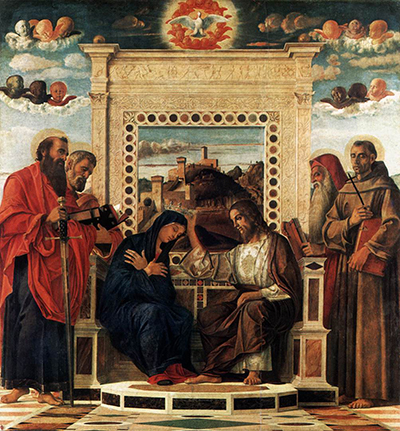Pesaro Altarpiece, an oil on panel painting, was executed by Giovanni Bellini, and it dated from 1471 to 1483.
It's regarded as one of Giovanni's first mature works, although there are some doubts on who commissioned it and its dating. The work's technique is proof of early use of oils plus blue smalt, which is a glass industry by-product.
It was used before in the Low Countries in the 1455 The Entombment by Bouts, but this marked the first use of smalt in Italian art, 20 years before Leonardo used it in 1492 in the apartments at Ludovico il Moro. Also, Bellini uses the more common azurite and lapis lazuli for other blues in his work. It was in the Marche-based San Francesco church when the building was suppressed in 1797 under the French occupation. It was moved to the city council; after many issues, it was then transferred to the city's museum, where the painting still hangs.
Pilasters
Two pilasters hold the cornice, each 61 centimetres and 25 centimetres, and each one with one deep perspective. The left-hand pilaster shows saints John the Baptist, Anthony of Padua, Lawrence and Catherine of Alexandria. The right-hand pilaster shows Andrew, Louis of Toulouse, Bernardino of Siena and blessed Michelina. Around this time, the Franciscans promoted most of these saints. George was linked as a 'holy knight' to the court, while saint Terence, who is the Roman soldier in the painting, was Pesaro's patron saint.
Coronation of Mary
The main central panel is showing the Coronation of Mary, often shown on earth instead of heaven. To the right are Saint Francis and Saint Jerome while to the left are Saint Paul and Saint Peter. Christ and Mary are sitting on a marble throne. The open back of the marble throne shows a realistic rocky landscape, which is surrounded by a border similar to the original frame of the gilded intaglio for the work.
There is the Holy Spirit dove in the upper centre, with seraphim and cherubim to its right and left. The floor in the painting is set with marble inlays, emphasising the balance and the perspective of the composition. Giovanni combines lessons drawn from Andrea Mantegna, his brother-in-law, with clear light plus a synthesis between landscape, figures and architecture drawn from the Italian painter Piero della Francesca and Antonello da Messina's oil technique, both of whose work Giovanni may have seen when he visited his mother's homeland, the Marche.




